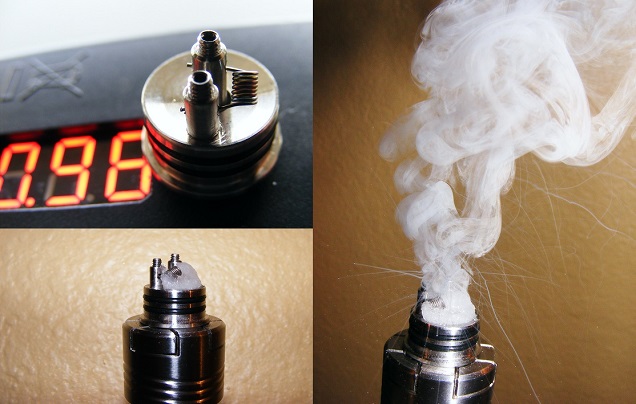
A new study has looked into the effect of e-cigarette vapor and liquid on the lungs, and has found evidence of oxidative stress, inflammation and toxicity. Additionally, dripping e-liquid directly onto coils increases the production of reactive oxygen species (ROS i.e. free radicals). The findings are relatively similar to another recent study, except this one doesn’t depend on such obvious misuse of devices. Admittedly, there are hints of inappropriate usage conditions, and some toxicity tests were conducted on e-liquid itself rather than the vapor produced from it, but the findings aren’t easy to brush aside. The good news is, while e-cigarettes may be worse than air, the study does indicate that e-cigarettes are –as expected – much safer than cigarettes.
Summary
- Researchers tested an eGo Vision Spinner and a Blu cig-a-like for their production of reactive oxygen species (ROS), tested liquids and vapor on cells and exposed mice to e-cig vapor.
- Both the coil itself and the process of vaporization appear to generate ROS, and based on tests of the exposed coil of a clearomizer, dripping may increase production.
- E-liquid (not vapor produced from it, which would be more directly useful) was tested on cells, and generally had less of an impact than cigarette smoke. Cinnamon flavors in particular appear to promote inflammation in lung cells.
- Tests on mice indicate that e-cigarettes lead to oxidative stress in the lungs, but findings contradict those of a recent, similar (although less reliable) piece of research.
- Despite these concerns in comparison to abstinence, vaping is still undoubtedly much safer than smoking.
What They Did – Looking at ROS Production, E-Cigs’ Impact on Cells and on Mice
The researchers looked at several different things in this study, with details available in the full text (which is free). They used two devices: an eGo Vision Spinner with bottom-coil clearomizer and a Blu eCigs cig-a-like with disposable cartridge. They gave the resistance of the clearomizer as 2.2 ohms, but unfortunately didn’t provide information as to the voltage used (meaning it could be anything from 3.3 to 4.8 V, producing powers from around 5 to 10.5 W).
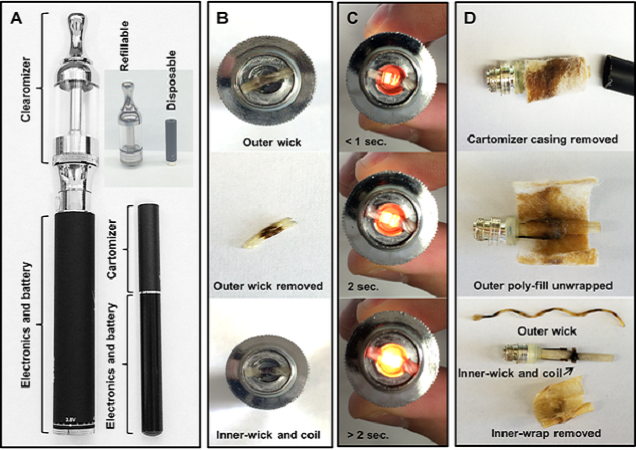
The study involved looking at the quantities of ROS detected in e-cig vapor, looked at the effect of PG, VG and commercially-available e-liquids (two tobaccos – both with and without nicotine – one grape and one cinnamon – both without nicotine) on cultured human bronchial and lung cells (cigarette smoke extract was also tested), looked at the effect of e-cig aerosol on the cells, investigated the impact on cell viability and also looked at the effects of exposing mice to vapor. The mice were exposed for 5 hours a day for three days, which is obviously a little extreme in length of exposure, but clearly not as bad as in the other recent study (which gave strong indications that cartridges were used for way too long). The mice were examined after exposure.
What They Found – ROS Levels in E-Cigs: Dripping is Worse than Using Tanks
Reactive oxygen species (ROS) are closely tied to oxidative stress, and the researchers found that they were produced by both the cig-a-like Blu eCig and the eGo brand. The results show that both tobacco and menthol Blu cartomizers increase the levels in comparison to air, but nicotine-containing liquids appear to have lower levels than non-nicotine ones. The same basic results were obtained for the eGo device, with PG producing more ROS than air, the VG producing more than PG and the no-nicotine tobacco e-liquid producing the most. No direct comparison with cigarette smoke was provided, but the other recent study put the levels of free radicals in e-cig vapor at about 140 times less than in cigarette smoke.
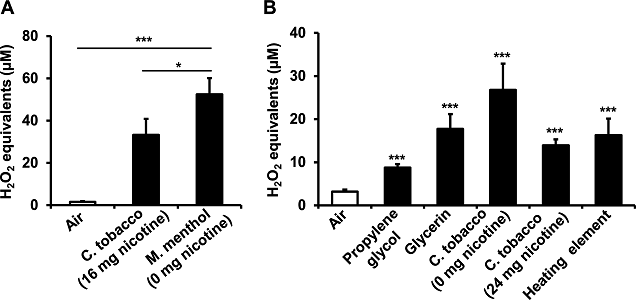
They determined that the coil in the e-cig was one source of these chemicals by activating the device without e-liquid applied. The authors also determined that levels start to decrease (towards those observed in the air “control”) with more uses of the coil. To see if e-liquid vaporization was also a source of the chemicals, the authors then placed two drops of e-liquid onto the coil, which was previously used a few times without e-liquid, and proceeded to use it for several puffs (taking place over five minutes). It’s obvious that two drops is not sufficient for five minutes of use, but the results do show a notable spike in the ROS levels, indicating that the vaporization of liquid also generates these chemicals.
To test the effect of dripping, the authors conducted two trials with the cartomizer filled up, and two more with the coil exposed and liquid directly applied to it. The difference was notable, with levels increasing to around 4 to 6 times higher than that observed in the full-clearomizer tests. It’s worth noting that this isn’t using an RDA, it’s using a bottom-coil clearomizer with the coil exposed. The only potential issue with this is that the coil could have been inadequately supplied with liquid (as a comment on the study points out), and it’s possible that dry puffs have a role to play in what’s being observed.
Testing E-Liquids and Vapor on Cells
The other major portion of the study concerned the effects of e-cigarettes on cells. Much of this testing was done with e-liquids, however, diluted to 1 percent and 5 percent, which were compared with cigarette smoke extract. The problem with testing on liquids is that different components of e-liquid respond to vaporization in different ways, and so the liquid itself isn’t likely to have the same composition as the aerosol, particularly because many by-products are made during heating and there is much less nicotine in vapor than in e-liquid. Dr. Farsalinos made this point at the E-Cigarette Summit in London in 2013, and used the differing results of toxicology studies conducted on liquids and vapor to make the point. In his studies, cigarette smoke was consistently toxic to cells, whereas only some specific flavors showed the same effect in e-cigarettes.
The e-liquid did impact on the cells, with the tobacco e-liquids at the higher concentration having the greatest effect. However, when the 1 percent e-liquid extract is compared with the cigarette smoke extract (which was only tested at 1 percent) it’s clear that e-liquid has a smaller effect on the number of cells, and PG and VG had less of an effect than commercial e-liquids (in line with Dr. Farsalinos’ earlier results). Generally speaking, the effect of e-liquids at 5 percent concentration was comparable to that of cigarette smoke’s at 1 percent dilution, even with the potential impact of testing liquid instead of vapor.
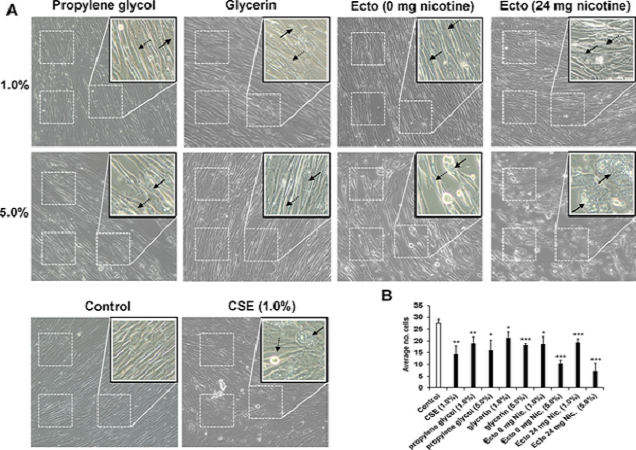
When they looked at the viability of human lung cells after e-liquid exposure in comparison with nothing (the control) and cigarette smoke exposure, the researchers found that a 2.5 percent concentration (of PG, VG or commercially-available liquids) didn’t have any significant effect in comparison to the control, whereas cigarette smoke at the same concentration drastically reduced viability.
When looking specifically at a chemical (interleukin 8, or IL-8) which attracts inflammatory cells and is released after smoking, the researchers found that only one of the e-liquids (the cinnamon flavor) lead to notable increase in IL-8. The rest led to much lower levels than observed with cigarette smoke exposure (keeping in mind that the cigarette smoke was only half as concentrated as the vapor). High nicotine liquids have a bigger effect than no-nicotine liquids, but this was still over four times lower than after cigarette smoke exposure. When vapor was used, levels of IL-8 and IL-6 (a pro-inflammatory chemical) increased in comparison to the air-exposed group.
Effects of E-Cig Vapor Exposure on Mice
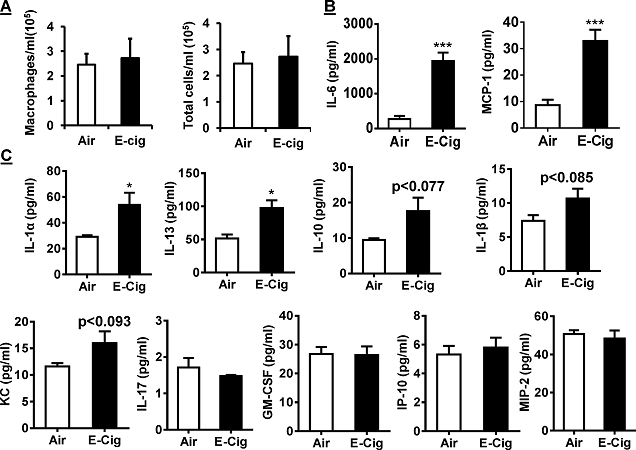
Finally, the researchers looked at the effect of inhaling vapor on mice, and found evidence of inflammation in their lungs. While many of the specific measures are unaffected – there is a good explanation of what each one does in a Reddit comment – there were significant increases in IL-6, IL-13, IL-1alpha (another pro-inflammatory chemical) and MCP-1 (which tells immune cells to go to site of inflammation) levels between the air and e-cig exposed mice. However, with regards to these findings, the other recent study has some conflicting results: IL-6 was lower in the e-cig treated mice, the MCP-1 levels were no different (a little lower, if anything) and there was a difference in macrophages (but none in this study). The other study may have been obviously flawed, but it’s clear that clarification is needed by further research.
Conclusion – E-Cigs Aren’t Perfect, but Vapor is Better Than Smoke
The authors do point out that while carbonyl levels (like formaldehyde, acrolein and acetaldehyde) are 9 to 807 times lower in e-cigarettes in comparison to cigarettes, but suggest that the role of oxidizing agents may currently be understated. Additionally, it appears (as has been suggested before) that flavorings are a key element in determining the impact of vaping on the body, with cinnamon in particular looking worse than others.
Normally, negative findings like this have serious limitations, but (at least as a layman) everything here seems relatively robust, apart from the few issues noted. In short, unless Dr. Siegel or Dr. Farsalinos is on the verge of publishing a blog post explaining a serious issue we’ve overlooked, this is one to be taken fairly seriously (although for the dripping-related conclusions, findings from an actual RDA would be preferable). The basic message is that inhaling e-cig vapor isn’t ideal, but this doesn’t impact on the comparative benefits of switching to vaping from smoking. We need more research to fully quantify the risks associated with vaping, but there is still no indication that it is as dangerous as smoking, and is highly likely to be much, much less so.

